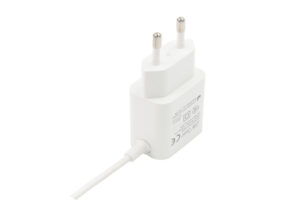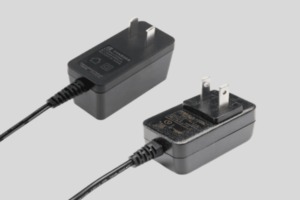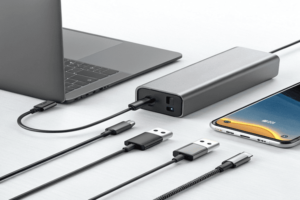Frustrated with power adapters that scratch easily or look cheap? Poor surface finishing can really let down an otherwise great electronic product. This is where the right surface treatment makes all the difference.
Choosing the optimal surface treatment—like electroplating for conductivity or anodizing for aluminum durability—is key to enhancing your power adapter’s appearance, lifespan, and overall user satisfaction. This directly impacts your product’s perceived quality and market success.
Over my many years at Quankang Technology, I’ve seen countless projects where the surface treatment was the unsung hero. It’s more than just aesthetics; it’s about performance and longevity. Let’s dive into some of the common techniques we use and discuss how they can significantly benefit your product designs. It’s a detail that can make or break the user experience.
What Makes Electroplating a Go-To for Power Adapter Components?
Are your power adapter connectors tarnishing or causing intermittent connections? This not only frustrates users but can also lead to product returns and damage your brand’s reputation. Electroplating offers a reliable solution.
Electroplating deposits a precise metal layer onto metal or plastic surfaces through electrolysis. This process enhances corrosion resistance, improves electrical conductivity (especially with gold plating), and increases surface hardness for critical power adapter components like plugs and terminals.
At Quankang, we often use electroplating for critical contact points. I remember a specific project for a client who needed an ultra-reliable connector for a medical-grade power adapter. The stakes were high. We opted for a multi-layer plating process, starting with a copper base, then a nickel barrier, and finally a gold flash on the contact surfaces. The copper provides excellent initial conductivity, nickel prevents copper migration into the gold layer (which can degrade performance over time), and gold ensures a corrosion-free, low-resistance contact. For a designer like Jacky, understanding these layers is crucial. It’s not just about choosing "gold plating"; it’s about specifying the right underlayers and thickness for the application.
We also had to consider the wear cycles. Thicker gold lasts longer but costs more. We ran extensive tests to find the optimal balance for that specific medical device, ensuring it met both performance and budgetary requirements. This detailed approach to electroplating is what sets a high-quality adapter apart.
Key Considerations for Electroplating:
- Substrate Material: The base material (metal or plastic) dictates the feasibility and specific pre-treatment steps needed for successful plating.
- Plating Material Choice:
- Zinc: Offers good corrosion resistance at a low cost, often used for internal components or chassis parts.
- Nickel: Provides wear resistance and a good underlayer for other nobler metals. Can be decorative too.
- Gold: Excellent conductivity and corrosion resistance, ideal for critical contacts, but more expensive.
- Tin: Good solderability and corrosion resistance, often used on terminals.
- Thickness Control: Crucial for performance and cost. Thicker layers offer more protection but increase material usage and process time.
- Environmental Concerns: Effluents from plating processes need careful management to comply with regulations like ROHS.
Here’s a simple table summarizing common plating choices for adapters:
| Plating Metal | Primary Benefit | Common Adapter Application | Relative Cost |
|---|---|---|---|
| Zinc | Corrosion Resistance | Internal brackets, screws | Low |
| Nickel | Wear Resistance, Base Layer | Connector shells, ground pins | Medium |
| Tin | Solderability, Conductivity | PCB contacts, terminals | Medium |
| Gold | Best Conductivity, Corrosion | High-performance contact pins | High |
Understanding these factors helps us deliver power adapters that not only look good but perform reliably for years.
How Can Spray Coating Transform Your Power Adapter’s Look and Feel?
Is your product’s plastic enclosure looking a bit bland or feeling cheap? Standard plastic finishes can lack visual appeal and may not offer sufficient protection against daily wear and tear. Spray coating can completely change this.
Spray coating applies a uniform layer of paint to the product’s surface using air pressure or electrostatic action. This method offers diverse aesthetic options, protects the underlying material, and can enhance the product’s tactile feel and scratch resistance.
I recall a time we were developing a new consumer power adapter, and the client wanted a specific Pantone color to match their brand identity, along with a soft-touch feel. Standard injection molded plastic just wouldn’t cut it. Spray coating was the perfect solution. We worked with our paint suppliers to get an exact color match and selected a polyurethane-based paint with a soft-touch additive. The result was a power adapter that not only looked premium but also felt great in the hand. For Jacky, a product designer, this level of customization is invaluable. Spray coating isn’t just about color; it’s about texture, gloss level (from matte to high gloss), and even special effects like metallic or pearlescent finishes. We also had to consider the durability. We tested different coating thicknesses and curing processes to ensure the finish would resist scratches from keys in a bag and everyday handling. The choice of paint chemistry is also critical for adherence to the specific plastic used (ABS, PC, or blends) and for meeting environmental regulations regarding VOCs (Volatile Organic Compounds).
Types and Benefits of Spray Coating:
- Liquid Spraying:
- Offers a wide range of colors and finishes (matte, satin, gloss, metallic, soft-touch).
- Can be applied in thin, controlled layers.
- Suitable for complex shapes.
- Powder Coating:
- Extremely durable and resistant to chipping, scratching, and fading.
- More environmentally friendly as it typically emits near-zero VOCs.
- Often results in a thicker, more robust coating. Primarily used on metal parts but can be adapted for some plastics.
Here’s how spray coating helps address design challenges:
| Feature Benefit | Description | Impact for Designers (like Jacky) |
|---|---|---|
| Aesthetic Variety | Achieves specific brand colors, textures, and gloss levels. | Enhances brand identity and perceived product value. |
| Substrate Protection | Shields the base material (usually plastic) from UV degradation and wear. | Increases product lifespan and maintains appearance over time. |
| Improved Feel | Soft-touch coatings can significantly enhance the tactile user experience. | Differentiates product in a crowded market, adds premium feel. |
| Cost-Effectiveness | Can be a cost-effective way to achieve custom looks on standard enclosures. | Balances aesthetic goals with budget constraints. |
By carefully selecting the type of paint and application process, we ensure the power adapter shell is not just a container, but a key part of the product’s overall quality and appeal.
Why is Anodizing a Premium Choice for Aluminum Power Adapters?
Are you designing a high-end electronic device with an aluminum power adapter? Untreated aluminum can scratch easily and lacks the premium feel your product deserves, potentially undermining its perceived value. Anodizing is the answer.
Anodizing is an electrochemical process that converts the surface of aluminum into a durable, corrosion-resistant, anodic oxide finish. This process significantly enhances wear resistance, offers various color options, and provides good electrical insulation.
We’ve worked on several projects where the client specifically requested aluminum enclosures for their power adapters, aiming for that sleek, premium look often associated with high-end electronics. For these, anodizing is our go-to surface treatment. I remember one instance where we were designing a slimline adapter to accompany a new laptop. The client wanted it to perfectly match the laptop’s "space gray" anodized finish. This required precise control over the anodizing bath chemistry and dyeing process. Anodizing isn’t just about color; the oxide layer created is incredibly hard, much harder than raw aluminum. This makes the surface very resistant to scratches and wear. For a product designer like Jacky, this is a huge benefit because it means the adapter will maintain its pristine look even with daily handling and travel. Furthermore, the anodized layer is an electrical insulator, which can be an added safety benefit in some designs. It also provides an excellent surface for laser etching logos or regulatory information, creating a very clean and permanent marking.
Key Advantages of Anodizing Aluminum:
- Durability: The anodic oxide layer is integral to the aluminum, so it doesn’t chip or peel like paint. It’s highly resistant to abrasion.
- Corrosion Resistance: Seals the aluminum surface, protecting it from environmental factors.
- Aesthetics: Allows for a wide range of colors (clear, black, grays, blues, reds, etc.) that are fade-resistant. The finish can also range from matte to bright.
- Dielectric Properties: The oxide layer is a good electrical insulator.
- Recyclability: Anodized aluminum is still fully recyclable.
Consider these aspects when choosing anodizing:
| Aspect | Detail | Implication for Jacky’s Design |
|---|---|---|
| Alloy Selection | The specific aluminum alloy affects the final color and finish quality. | Must choose alloy compatible with desired anodizing outcome. |
| Color Matching | Can be challenging across batches; requires tight process control. | Important for consistency if parts are made at different times. |
| Surface Prep | Pre-treatment (e.g., etching, brightening) influences the final appearance. | Matte or bright finishes can be achieved. |
| Thickness | Type II (decorative) vs. Type III (hardcoat) offer different protection. | Type III is much thicker and more durable but can alter dimensions. |
Anodizing truly elevates aluminum power adapters, giving them a look and feel that matches premium electronic devices.
Can a Brushed Finish Give Your Power Adapter a High-End Appeal?
Are you looking for a way to make your metal-cased power adapter stand out with a sophisticated, textured look? A simple polished or painted surface might not convey the premium quality you’re aiming for. A brushed finish could be the ideal solution.
A brushed finish is a mechanical process that creates a unidirectional satin texture on a metal surface. It imparts a distinctive, high-end look, helps hide fingerprints and minor surface imperfections, and can even slightly improve wear resistance.
I’ve seen the impact a brushed finish can have on product perception. We once designed a power adapter for an audio equipment company. They wanted a very tactile and visually refined look for the aluminum casing. We proposed a brushed finish followed by a clear anodizing layer to protect it. The result was stunning. The fine lines of the brushing caught the light beautifully, giving it a sense of depth and craftsmanship. For designers like Jacky, a brushed finish offers a subtle yet powerful way to differentiate a product. It’s not just about looks; the texture is less prone to showing fingerprints and small scuffs compared to a highly polished surface. This means the adapter stays looking good for longer. The process involves abrading the surface with a grit belt or wheel. The direction of the brushing, the grit size, and the pressure all affect the final appearance, allowing for a range of effects from fine and subtle to coarse and industrial.
Why Opt for a Brushed Finish?
- Unique Aesthetic: Provides a distinctive, linear grain pattern that looks sophisticated and modern.
- Reduced Smudging: The textured surface is less likely to show fingerprints and smudges compared to smooth, glossy surfaces.
- Conceals Imperfections: Can mask minor scratches or defects on the metal surface.
- Enhanced Tactile Feel: Adds a pleasant textural element to the product.
Here’s a breakdown of considerations for brushing:
| Consideration | Details | Impact for Design |
|---|---|---|
| Material | Best suited for metals like aluminum and stainless steel. | Material choice is key; not all metals brush well or achieve the desired look. |
| Grain Direction | The direction of the brushing lines is a key design element. | Must be considered in relation to the product’s form and how it will be viewed. |
| Grit Size | Finer grits produce a smoother, more satin-like finish; coarser grits create a more pronounced texture. | Allows customization of the texture’s visual and tactile intensity. |
| Protective Coat | Often followed by clear anodizing (for aluminum) or passivation (for stainless steel) to prevent corrosion and wear. | Essential for maintaining the appearance and integrity of the brushed surface. |
A brushed finish, when executed well, can significantly elevate the perceived value and aesthetic appeal of a power adapter, especially for products targeting a premium market segment.
When is Sandblasting the Right Preparation for Power Adapter Surfaces?
Do you need a uniform matte finish on your power adapter casing, or are you looking to improve paint adhesion for a subsequent coating process? Simply molding the plastic or forming the metal might not provide the ideal surface characteristics. Sandblasting can be a crucial preparatory step.
Sandblasting propels abrasive media at high velocity against a surface. This process cleans the surface, removes oxides or old coatings, and creates a uniformly roughened, matte texture, which significantly improves adhesion for subsequent paints or coatings.
In our experience at Quankang Technology, sandblasting is often a critical, though sometimes unseen, step in achieving a high-quality final finish. I remember a project where we were struggling with paint adhesion on a particular batch of die-cast aluminum power adapter housings. The paint was flaking in certain areas after environmental testing. The solution was to incorporate a light sandblasting step before painting. This created a micro-roughened surface that gave the paint much more to "grip" onto, solving the adhesion problem completely.
For a product and mold designer like Jacky, understanding the role of sandblasting is important, not just for aesthetics but for functional reasons like paint durability. It’s also excellent for creating a consistent, non-reflective matte finish, which is often desired for professional equipment or products where glare is a concern. The choice of abrasive media (e.g., glass beads, aluminum oxide, walnut shells) and blasting pressure allows for fine-tuning the resulting surface texture and roughness.
Benefits and Applications of Sandblasting:
- Uniform Matte Finish: Creates an even, non-directional, low-gloss surface.
- Enhanced Adhesion: The roughened surface provides an excellent mechanical key for paints, powder coatings, and other finishes.
- Surface Cleaning: Effectively removes rust, scale, old paint, and other contaminants.
- Stress Relief: Can sometimes help relieve surface stresses in metal parts.
- Deburring: Can remove small burrs from machined or molded parts.
Key factors to consider for sandblasting:
| Factor | Description | Relevance for Jacky |
|---|---|---|
| Abrasive Media | Different media (glass beads, sand, aluminum oxide, plastic beads) produce different finishes and effects. | Choice depends on base material and desired roughness/finish (e.g., glass beads for a fine satin finish). |
| Nozzle Pressure/Angle | Controls the intensity of the blasting and the resulting surface profile. | Needs careful control to avoid damaging delicate parts or creating an overly rough surface. |
| Masking | Areas not to be blasted must be masked off, adding a step to the process. | Important for protecting critical features, threads, or surfaces that need to remain smooth. |
| Material Impact | Can slightly remove material, so it might not be suitable for parts with very tight tolerances if not controlled. | Dimensional changes, though usually minimal, need to be accounted for in the design. |
Sandblasting is a versatile process that plays a vital role in preparing power adapter surfaces for final finishing or for achieving a specific aesthetic and functional matte look.
Conclusion
Choosing the right surface treatment is vital for your power adapter’s appearance, durability, and perceived value. Each method offers unique benefits, impacting both aesthetics and long-term performance.








